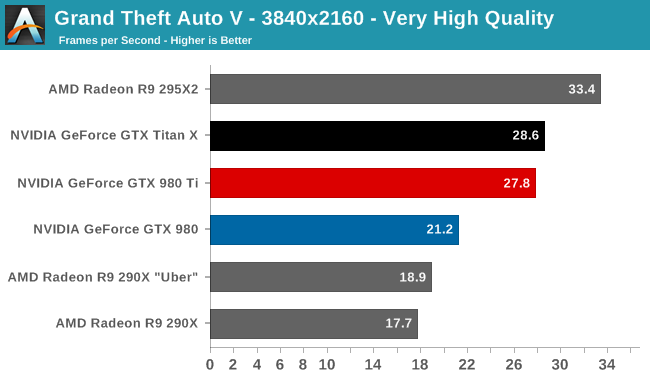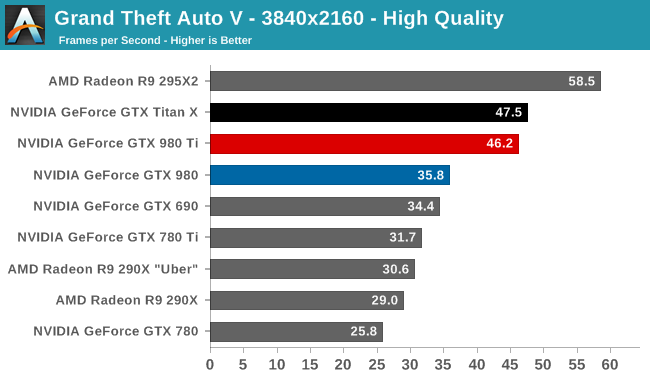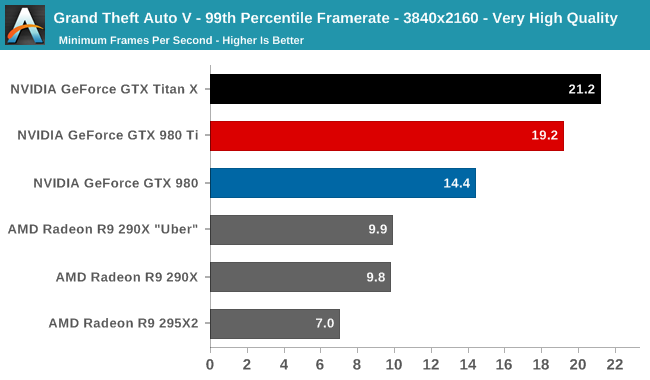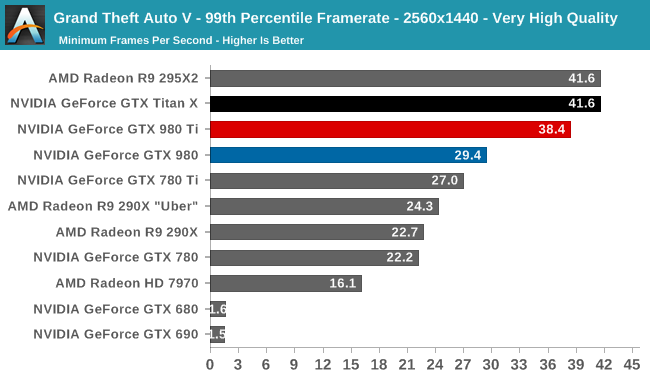The NVIDIA GeForce GTX 980 Ti Review
by Ryan Smith on May 31, 2015 6:00 PM ESTGrand Theft Auto V
The final game in our review of the GTX 980 Ti is our most recent addition, Grand Theft Auto V. The latest edition of Rockstar’s venerable series of open world action games, Grand Theft Auto V was originally released to the last-gen consoles back in 2013. However thanks to a rather significant facelift for the current-gen consoles and PCs, along with the ability to greatly turn up rendering distances and add other features like MSAA and more realistic shadows, the end result is a game that is still among the most stressful of our benchmarks when all of its features are turned up. Furthermore, in a move rather uncharacteristic of most open world action games, Grand Theft Auto also includes a very comprehensive benchmark mode, giving us a great chance to look into the performance of an open world action game.
On a quick note about settings, as Grand Theft Auto V doesn't have pre-defined settings tiers, I want to quickly note what settings we're using. For "Very High" quality we have all of the primary graphics settings turned up to their highest setting, with the exception of grass, which is at its own very high setting. Meanwhile 4x MSAA is enabled for direct views and reflections. This setting also involves turning on some of the advanced redering features - the game's long shadows, high resolution shadows, and high definition flight streaming - but it not increasing the view distance any further.
Otherwise for "High" quality we take the same basic settings but turn off all MSAA, which significantly reduces the GPU rendering and VRAM requirements.



After initially expecting Grand Theft Auto to be a walk in the park performance wise, the PC version of the game has instead turned out to be a very demanding games for our GPUs. Even at 1440p we can’t have very high quality with MSAA and still crack 60fps, though we can get very close.
Ultimately GTA doesn’t do any better than any other game in setting apart our GM200 cards. GTX 980 Ti trails GTX Titan by 4% or less, essentially the average outcome at this point. Also average is the GTX 980 Ti’s lead over the GTX 980, with the newest card beating the older GTX 980 by 29-31% across our three settings. Finally, against the GTX 780 the GTX 980 Ti has another strong showing, with a 69-79% lead.
On an absolute basis we can see that at 4K we can’t have 4x MSAA and even crack 30fps on a single-GPU card, with GTX 980 Ti topping out at 27.8 fps. Taking out MSAA brings us up to 46.2fps, which is still well off 60fps, but also well over the 30fps cap that this game was originally designed against on the last-generation consoles.



Along with an all-around solid benchmark scene, the other interesting benchmarking feature of GTA is that it also generates frame percentiles on its own, allowing us to see the percentiles without going back and recording the game with FRAPS. Taking a look at the 99th percentile in this case, what we find is that at each setting GTA crushes some group of cards due to a lack of VRAM.
At 4K very high quality, 4GB cards have just enough VRAM to stay alive, with the multi-GPU R9 295X2 getting crushed due to the additional VRAM requirements of AFR pushing it over the edge. Not plotted here are the 3GB cards, which saw their framerates plummet to the low single-digits, essentially struggling to complete this benchmark. Meanwhile 1440p at high quality crushes our 2GB cards, with less VRAM than a Radeon HD 7970 falling off of the cliff.
As for what this means for the GTX 980 Ti, the situation finds the GTX 980 Ti trailing the GTX Titan X in 99th percentile framerates by anywhere between 3% and 10%. This test is not designed to push more than 6GB of VRAM, so I’m not entirely convinced this isn’t a wider than normal variance (especially at the low framerates for 4K), though the significant and rapid asset streaming this benchmark requires may be taking its toll on the GTX 980 Ti, which has less VRAM for additional caching.










290 Comments
View All Comments
douglord - Monday, June 1, 2015 - link
I need to know if the 980ti can output 10-bit color correctly? Is it ready for UHD Blueray?dragonsqrrl - Monday, June 1, 2015 - link
To my knowledge only Quadro's and Firepro's output 10 bit color depth.johnpombrio - Monday, June 1, 2015 - link
Any card that can do true RGB color schemes are NOT MEANT for normal users. It brings a lot of drawbacks for games and normal tasks. These type of cards are for graphics professionals only. Google it to see why.mapesdhs - Wednesday, June 3, 2015 - link
Indeed, the way colourspaces interact with different types of monitor can result in some nasty issues for accurate colour presentation. For home users, it's really not suitable since so many normal apps & games aren't written to utilise such modes correctly. Besides, I doubt any 4K TVs could properly resolve 10bis/channel anyway. Funny though that people are still asking about 10bit colour when pro users were already using 12bit more than 20 years ago. :D Also 16bit greyscale for medical/GIS/etc.johnpombrio - Monday, June 1, 2015 - link
Yikes! That overclock ability! I always buy EVGA's superclocked NVidia cards as they as super stable and have great benchmarks (as well as playing games well, heh). I might buy into this even tho I have a GTX980.As for AMD, NVidia has 76% of the discrete GPU graphics card market (and still rising) while AMD has lost 12% market share in the last 12 months alone. Whatever AMD has up for new products, it better hurry and be a LOT better than NVidia cards. AMD has tried the " rebadge existing GPU family cards, reduce its price, and bundle games" for too long and IT IS NOT WORKING. C'mon AMD, get back into the fight.
mapesdhs - Wednesday, June 3, 2015 - link
True, I kept finding EVGA's cards work really well. The ACX2 980 (1266MHz) is particularly good.Nfarce - Monday, June 1, 2015 - link
Well I recently upgraded with a second 970 for SLI for 1440p gaming and have them overclocked to 980 performance. It's roughly 15% faster than this single card solution for $700 vs. $650 (7.5% increase in cost). But one thing is for certain: we are still a long time away from realistic 4K gaming with a G-sync 120Hz monitor when those come out. I would much prefer 1440p gaming with max quality and high AA settings and faster FPS matched to screen Hz than detuned 4K settings (even if AA is less meaningful at 2160p).By the way: are you guys ever going to add Project Cars to your benchmarks? It has rapidly become THE racer to own. Grid Autosport is not really a good benchmark these days because it's just a rehash of the Grid 2 engine (EGO 3.0)...easy on GPUs. Many, including me, haven't touched Autosport since PCars was released and may never touch it again.
mapesdhs - Wednesday, June 3, 2015 - link
Project Cards is one game that runs badly in CF atm (driver issues), which would make the 295x2 look horrible. Might be better to wait until AMD has fixed the issue first.agentbb007 - Monday, June 1, 2015 - link
A GTX Titan X for $649, DOH BART! Oh well I've enjoyed my SLI Titan X's for a few months so I guess that was worth the $700 premium. I keep falling for nVidia's Titan brand gimmick, I also bought the original Titan luckily just 1 of them and ended up selling it for about half what I paid.Lesson learned, AGAIN, don't buy the Titan brand wait for the regular GTX version instead.
mapesdhs - Tuesday, March 12, 2019 - link
2019 calling! I wonder if he bought the 2080 Ti or RTX Titan... :}